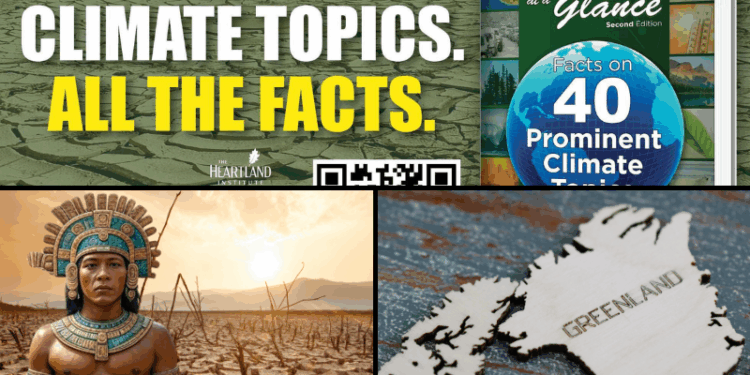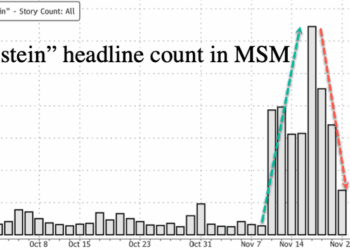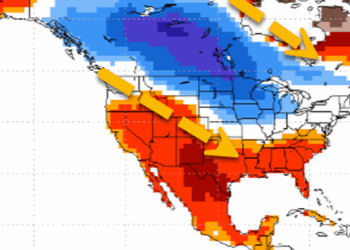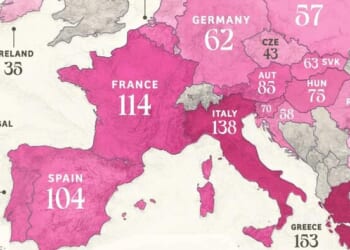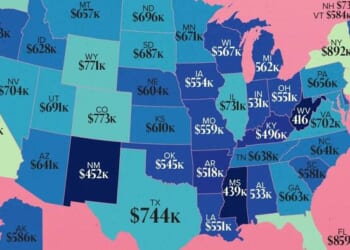IN THIS ISSUE:
- Climate at a Glance Redux! New Book Puts the Science Back in Climate Science
- Meso-American Megadroughts Were Worse in the Past
- Greenland Ice Melt Grossly Overstated
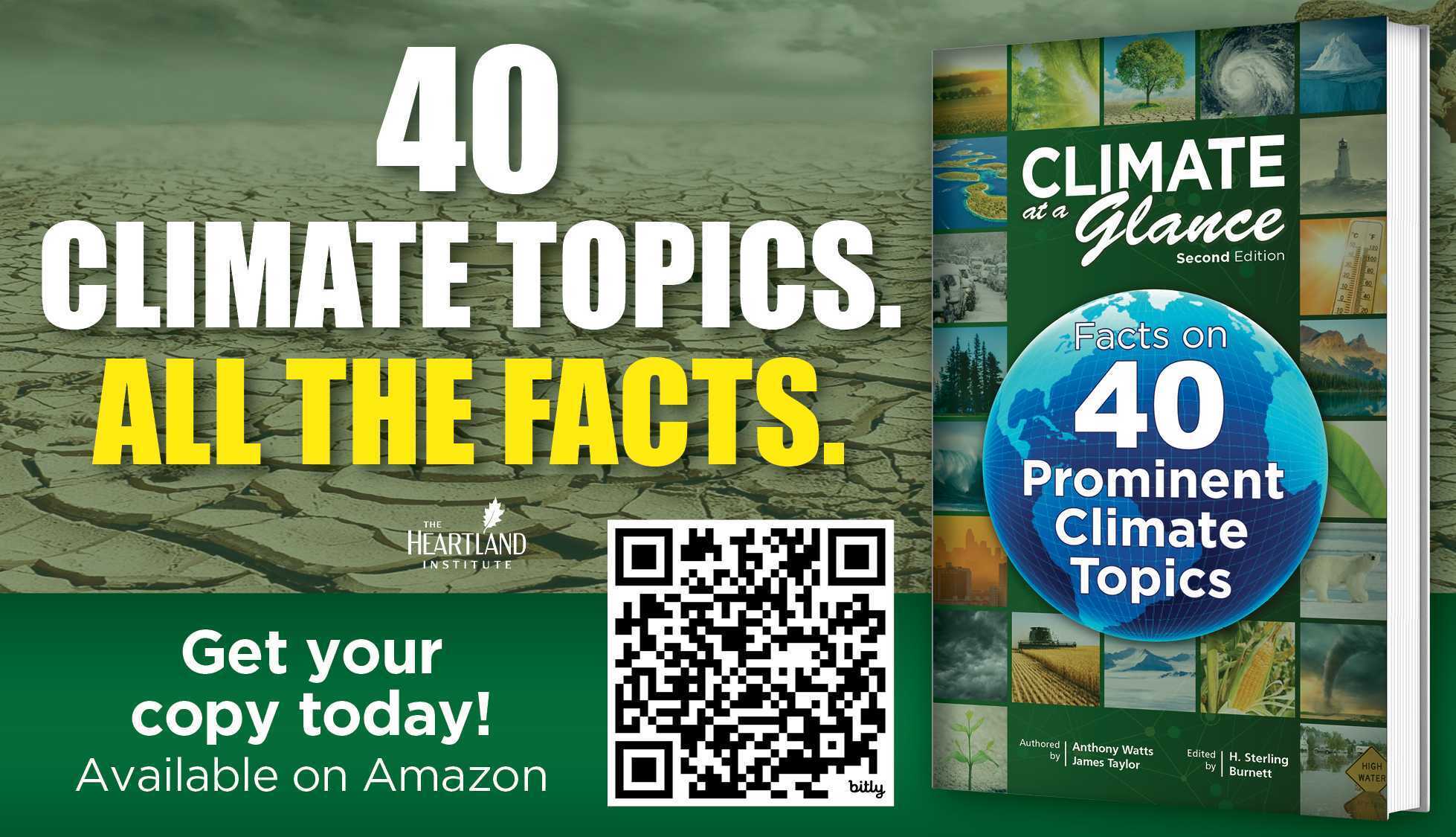
Climate at a Glance Redux! New Book Puts the Science Back in Climate Science
It is a truism that children are our future, but despite being trite, it is nonetheless important to reflect upon. Today’s young people will decide whether the American experiment as a constitutional republic that embraces individual freedom instead of collectivism or authoritarianism continues into the future. They are the future parents, our future workers and entrepreneurs, our future warriors, and our future leaders. As a result, because one of the Heartland Institute’s prime foundational goals is to ensure the freedom and prosperity of future generations, we have long pursued education policy. Progressives may be paternalistic and venal in their quest of influence and power, but they aren’t stupid, which is why they also put a great deal of effort into controlling who is judged qualified to teach, how schools are licensed and organized, the administration of schools and makeup of school boards, and education policy at the state and federal levels.
Heartland has long supported school choice, in the belief that competition will produce better educational outcomes, a more autonomous, independent populace, and parental choice. Heartland has also looked at school curricula. As part of our efforts, Heartland has worked for more than two decades to counter the growing influence of environmental and climate alarmists over school curricula.
I personally have undertaken official reviews and comments on science and social studies textbooks being considered for use in Texas and West Virginia, for example, highlighting the absence of the teaching of the scientific method, the importance of skepticism and active debate, the fact that consensus is a political term and not a scientific one, and specifically of efforts to keep skeptical, fact-informed critiques of the dominant narrative that human fossil-fuel use is an unmitigated bad because it is causing a climate crisis out of the books, the lesson plans, and the classroom entirely.
Concerning climate change, the textbooks I examined, many of them later rejected or modified before being endorsed for use by state agencies, uniformly taught students what to think about climate change, not how to think about climate change. That’s indoctrination, not the scientific pursuit of knowledge and truth.
At the behest of a number of members of a couple of states’ boards of education, I also provided detailed critiques of Next Generation of Science Standards being considered for adoption by various states, and of the science standards promoted by National Assessment Governing Board’s National Assessment of Educational Progress (NAEP) science framework.
Those efforts, while important, were in a sense like playing whack-a-mole, responding to dangerous climate miseducation on a state-by-state basis as the issue popped up on our radar. Our largest climate education endeavors have been our nationwide efforts to provide specific publications for use as supplementary material as discussions of climate change arise.
Beginning with the Nongovernmental International Panel on Climate Change (NIPCC) Climate Change Reconsidered series of books, at great expense and in succession over the years, The Heartland Institute has collaborated on, produced, and mailed thousands of copies of peer-reviewed, easy-to-understand research documents, delivered to thousands of school districts and science teachers across the nation.
Our biggest push came in 2017 when Heartland mailed approximately 300,000 copies of Why Scientists Disagree about Global Warming: The NIPCC Report on Scientific Consensus, to science teachers across the country. That effort resulted in dozens of stories in the mainstream media almost universally decrying Heartland’s attempt to bring reason and balance to classroom discussions of climate change. Liberal members of Congress, intent on using climate change as a wedge to open the door to expanded federal control over people’s personal choices and energy use, called on Heartland to stop the mailing, to which we responded with a resounding NO!.
Heartland championed the Constitution in this exchange, while the congressmen who swore an oath to defend the Constitution and its First Amendment stating the right to free speech violated their oaths by pushing for censorship. Although many teachers refused to consider using Why Scientists Disagree in their courses, dozens across the country requested additional copies to ensure each student in each of their classrooms had one.
Heartland’s next big climate education push was in 2023: the mailing of more than 8,000 copies of Climate at a Glance for Teachers and Students (CAAG) to school districts across the country. As with Why Scientists Disagree, CAAG was intended to supplement standard curricula and materials, in an effort to counter the alarmist narrative with facts on the climate that reflect current data and research. CAAG covered 30 climate topics in concise, two-page items with graphics. The topics covered are the core issues often discussed in science classes and among the general public and media. The book was written with laypeople in mind, to provide students and teachers alike with the data to show the Earth is not experiencing a climate crisis, complete with references they can access for further research. The book was designed to be easily utilized by teachers to integrate into their lesson plans, with its breakdown into five sections: (1) The Atmosphere and Land, (2) The Sea and Ice, (3) Temperatures and Extreme Weather, (4) Humans and Animals, and (5) Scientific and Policy Controversies.
Once again, the media misrepresented Heartland’s educational effort, portraying CAAG as trying to instill climate denial in the classroom. But also, once again, many public-school teachers and homeschool associations requested additional copies. On the basis of its positive reviews, CAAG became for a time the top-selling book on Amazon across several categories, such as “Science for Kids,” “Climatology,” and “Environmental Science.”
Which brings us to today. On October 7 The Heartland Institute released an updated CAAG second edition. A shortened version of the press release is below. It is my hope that Climate Change Weekly readers will purchase copies for themselves and as gifts for friends, to share with their own kids’ teachers, and will download the app for ease of access and use. Together we can make sound science great again, in part by making the CAAG second edition a bestseller in widespread use.
New ‘Climate at a Glance’ Book Challenges ‘Climate Crisis’ Narrative with Hard Data
The 118-page book covers 40 climate topics often discussed in science classes, as well as among the general public and media, and provides the data to show the earth is not experiencing a climate crisis. The book is organized into four sections: (1) Extreme Weather, (2) Economics and Policy, (3) Climate Change Impacts, and (4) Underlying Science. This makes it ideal as a tool for teachers to bring the latest climate data into their lesson plans.
The new, second edition covers 14 new topics not discussed in the first edition. They are: Global tropical cyclones; temperature-related deaths; deaths from extreme weather; the Great Barrier Reef; bees and climate change; Antarctic ice melt; Arctic sea ice; global greening; global wildfires; ocean temperatures; atmospheric rivers; climate models vs. measured temperature data; carbon dioxide saturation in the atmosphere; and the sun’s impact on climate change.
The following statements may be used for attribution. For more information about this book distribution, or to interview the authors, please contact Executive Vice President and Director of Communications Jim Lakely at [email protected] or call/text 312-731-9364.
“Climate at a Glance presents the compelling truth on the most frequently discussed climate change topics in two-page summaries that are easy to read and understand. You can feel confident in your knowledge of climate change topics with Climate at a Glance and you will never lose a climate change debate with a climate activist.”
James Taylor
President
The Heartland Institute
[email protected]
“For too long, climate discourse has been dominated by slogans and fear, while real science and sound policy have taken a back seat, but the data tell a far more complicated story. This book is not about denying that the climate changes—it always has and always will—but about questioning whether today’s costly, disruptive policies are grounded in evidence or in politics. By examining the data, the models, and the history of our ever-changing climate, this book cuts through the noise to show that climate change is not a one-way catastrophe but part of Earth’s natural variability. Instead of rushing into policies that wreck economies and livelihoods, we need honest science, open debate, and the courage to question a narrative that too often puts politics before facts.”
Anthony Watts
Senior Fellow for Environment and Climate
The Heartland Institute
[email protected]
“Climate Change is a fact. That it is resulting in disasters or measurable harms or poses an existential threat to humanity is straight-up false, as the chapters in Climate at a Glance 2nd Edition clearly show. The data and research cited in CAAG 2nd edition clearly demonstrate that climate models fail to reflect reality, neither temperatures nor sea levels are rising at unusual rates, and extreme weather events, and natural disasters that sometimes result from them, like wildfires and floods, aren’t becoming more frequent, severe, or deadly. Exposed to those facts, people who’ve developed anxiety, depression, or other mental illnesses tied to their exposure to the constant but false media drumbeat that climate change is killing them, should be able to happily get back on with their lives without fear that their driving or travel habits or food choices are destroying the Earth.”
Director, Arthur B. Robinson Center on Climate and Environmental Policy
The Heartland Institute
[email protected]
Here are a couple of facts in the book that counter common and false alarmist narratives about the climate:
Deaths from Extreme Weather, p. 20: Real-world data show no significant increase in extreme weather over the past 100 years, and existing data show weather-related deaths down dramatically.
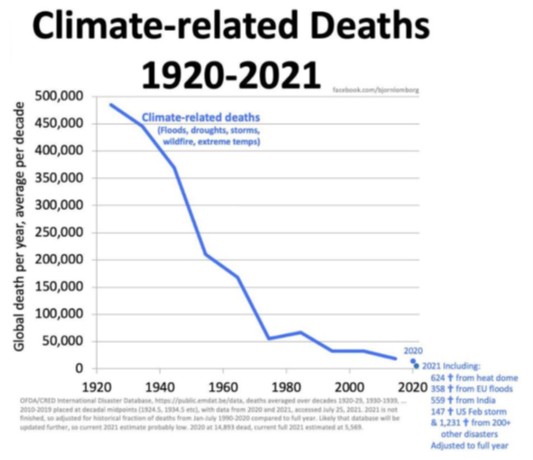
Global Tropical Cyclones, p. 22: There has been no increase in the number or intensity of tropical cyclones since at least 1972 as the planet has modestly warmed, and some data suggest tropical cyclone frequency has actually declined over the past century. Even the UN’s IPCC found no increase in the frequency or severity of tropical cyclones.
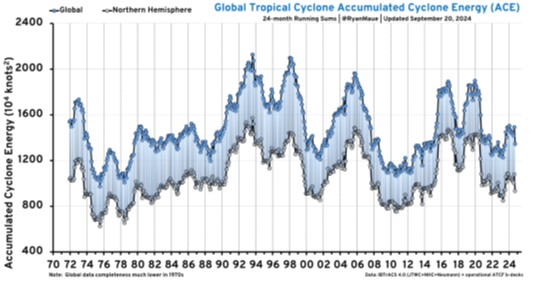
Sources: The Heartland Institute, The Heartland Institute
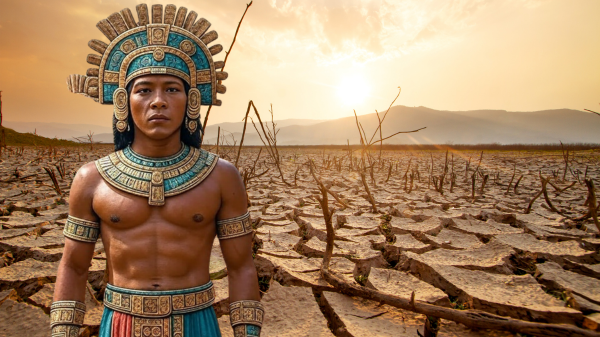
Meso-American Megadroughts Were Worse in the Past
Research published in the peer-reviewed journal Science Advances finds droughts aren’t unusual in the Amazon and that droughts in recent decades are in no way as severe or prolonged as those the region experienced in the past.
Using proxy data developed from examining stalagmites to develop a rainfall record of the lowlands of the Yucatan from the 800s through just over 1000 AD, the researchers found a long-term drought occurred that likely contributed to “sociopolitical upheaval and depopulation of cultural centers in the Maya Lowlands during the Terminal Classic Period.”
In particular, a 13-year megadrought from 929 to 942 AD corresponded with halted monument construction and political disruption at key Maya sites, plus population decline and dispersal.
In periods of time both before and after the megadrought the Maya experienced radical swings of extreme weather, with repeated periods of drought and extreme rainfall, and droughts followed by flooding were common—despite CO2 levels lower than today’s.
The stalagmite data indicate during the 150 years between 871 and 1021 AD the lowlands of the Yucatan experienced eight wet-season droughts lasting three or more years, broken up by one or two extremely wet rainy seasons. The longest drought of the period lasted 13 years. The water management techniques and technologies the Maya had developed to maintain sufficient water during the types of short-term droughts they had experienced previously were incapable of sustaining the large cities and temple complexes in the region during the extended drought(s), leading to decline and abandonment of many cities and complexes.
Inscriptions on the Maya temples confirm the dates of the extreme droughts up until the 13-year drought, when new inscriptions at Chichen Itza, one of the largest Mayan complexes ever developed, stopped entirely.
Sources: Jo Nova; Science Advances
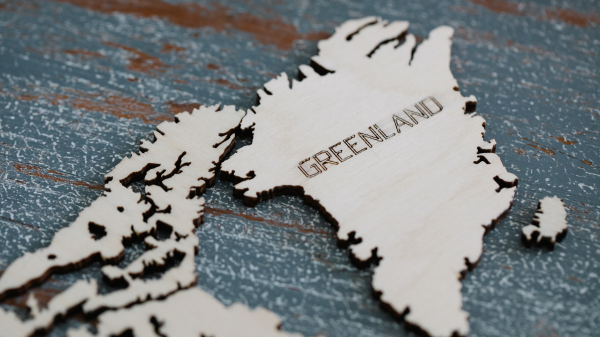
Greenland Ice Melt Grossly Overstated
New research published in Nature Communications reports that climate models, and previous research based on them, grossly overstate the contribution of Greenland’s ice melt to sea level rise.
The research confirms what Climate at a Glance: Greenland Ice Melt previously showed: when Greenland’s ice melts seasonally or even across a day or two days, much if not all of it refreezes, rather than flowing directly into the sea and contributing to sea level rise. The study’s abstract says,
There is growing evidence, however, that climate models overestimate runoff from this critical area of the ice sheet. Climate models traditionally assume that all bare-ice runoff enters the ocean, unlike porous firn, in which some meltwater is retained and/or refrozen. We used field measurements and numerical modeling to reveal that extensive retention and refreezing also occurs in bare glacier ice. We found that, from 2009 to 2018, meltwater refreezing in bare, porous glacier ice reduced runoff by an estimated 11–17 Gt a−1 in southwest Greenland alone, equivalent to 9–15% of this sector’s annual meltwater runoff simulated by climate models. This mass retention explains evidence from prior studies of runoff overestimation on bare ice by current generation climate models and may represent an overlooked buffer on projected runoff increases.
The study finds climate models overestimate the amount of meltwater runoff into the oceans from the key ablation zone (an area of extreme ice loss from melting) by more than 67 percent—meaning only a third of the meltwater estimated by climate models to reach the sea is actually doing so. That is not the only fact on the ground that climate model estimates get wrong. Climate models also overstate the size of glacial lakes that form on depressions in the ice during the peak summer melt by 21 percent to 58 percent. Also, satellite measurements show climate models overstate ice mass changes in Greenland by 21 to 47 percent and surface melting by between 14 and 40 percent. Ground-based sampling of sites confirms the satellite readings.
That means multiple sources of real-world data show climate models are fundamentally overstating what the climate consensus claims is a key indicator that humans are causing catastrophic climate change. Greenland isn’t melting in response to emissions nearly as much as is commonly asserted and thus isn’t contributing to rising seas to the extent asserted.
As Mandy Carr writes at The Cool Down, “It’s crucial that the climate models accurately calculate rising sea levels to help residents in the places that are going to be most affected. The Intergovernmental Panel estimates that the sea level will rise between 1.4 and 2.8 feet, but 6.6 feet isn’t being ruled out by 2100,” Carr writes. Yet the IPCC’s forecasts are based in large part on models’ estimates of meltwater from Greenland and Antarctica driving much of the sea level rise. If the meltwater from Greenland is much less than models assume, and if, as recent research indicates, Antarctica is adding ice, not shrinking, then the IPCC’s sea level rise estimates are also probably grossly overstated, putting the actual rate of sea level rise no more and possibly less than the natural rate of rise for most of the present interglacial period.
None of this is news to regular readers of CCW, since we reported previously on the unalarming rate of Greenland’s ice melt when discussing Climate at a Glance: Greenland Ice Melt, which detailed the fact the maximum amount of ice loss on Greenland is a virtually undetectable 0.005 percent per year, equaling less than 1 percent of its total ice mass loss over the past 45 years, in part due, as the new study confirms, to meltwater refreezing before it reaches open water. The contours of the ice on the continent may change, but the overall ice mass changes relatively little.
Sources: Nature Communications; The Cool Down; Climate at a Glance: Greenland Ice Melt

